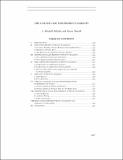| dc.contributor.author | Polinsky, A. Mitchell | |
| dc.contributor.author | Shavell, Steven | |
| dc.date.accessioned | 2013-07-30T15:25:36Z | |
| dc.date.issued | 2013-07-30 | |
| dc.identifier.citation | A. Mitchell Polinsky & Steven M. Shavell, The Uneasy Case for Product Liability, 123 Harv. L. Rev. 1436 (2010). | en_US |
| dc.identifier.issn | 0017-811X | en_US |
| dc.identifier.uri | http://nrs.harvard.edu/urn-3:HUL.InstRepos:10900865 | |
| dc.description.abstract | In this Article we compare the benefits of product liability to its costs and conclude that the case for product liability is weak for a wide range of products. One benefit of product liability is that it can induce firms to improve product safety. Even in the absence of product liability, however, firms are often motivated by market forces to enhance product safety because their sales may fall if their products harm consumers. Moreover, products must frequently conform to safety regulations. Consequently, product liability might not be expected to exert a significant additional influence on product safety — and empirical studies of several widely sold products fail to find an effect of product liability on the frequency of product accidents. A second benefit of product liability is that it can improve consumer purchase decisions by causing product prices to increase to reflect product risks. But because of litigation costs and other factors, product liability may raise prices excessively and undesirably chill purchases. A third benefit of product liability is that it compensates victims of product-related accidents for their losses. Yet this benefit is only partial, for accident victims are frequently compensated by insurers for some or all of their losses. Furthermore, the payment of compensation for pain and suffering actually reduces the welfare of individuals because it effectively forces them to purchase insurance for a type of loss for which they ordinarily do not wish to be covered. Offsetting the potential benefits of product liability are its costs, which are great. Notably, the transfer of a dollar to a victim of a product accident via the liability system requires more than a dollar on average in legal expenses. Given the limited benefits and the high costs of product liability, we come to the judgment that its use is often unwarranted. This is especially likely for products for which market forces and regulation are relatively strong, which includes many widely sold products. On the other hand, the use of product liability may be desirable for products for which these factors are weak. Our generally skeptical assessment of product liability for products for which market forces and regulation are strong is in tension with the broad social endorsement of such liability. | en_US |
| dc.language.iso | en_US | en_US |
| dc.publisher | Harvard University, Harvard Law School | en_US |
| dc.relation.isversionof | http://www.harvardlawreview.org/media/pdf/polinsky_shavell.pdf | en_US |
| dc.relation.hasversion | http://www.stanford.edu/group/siepr/cgi-bin/siepr/?q=system/files/shared/pubs/papers/briefs/policybrief_1009_1v2.pdf | en_US |
| dash.license | OAP | |
| dc.title | The Uneasy Case for Product Liability | en_US |
| dc.type | Journal Article | en_US |
| dc.description.version | Version of Record | en_US |
| dc.relation.journal | Harvard Law Review | en_US |
| dash.depositing.author | Shavell, Steven | |
| dc.date.available | 2013-07-30T15:25:36Z | |
| dash.contributor.affiliated | Shavell, Steven | |


